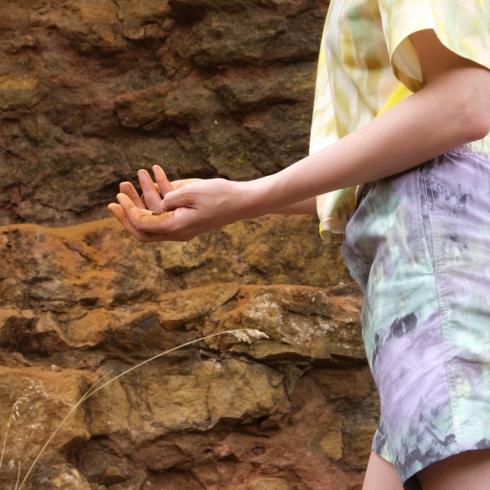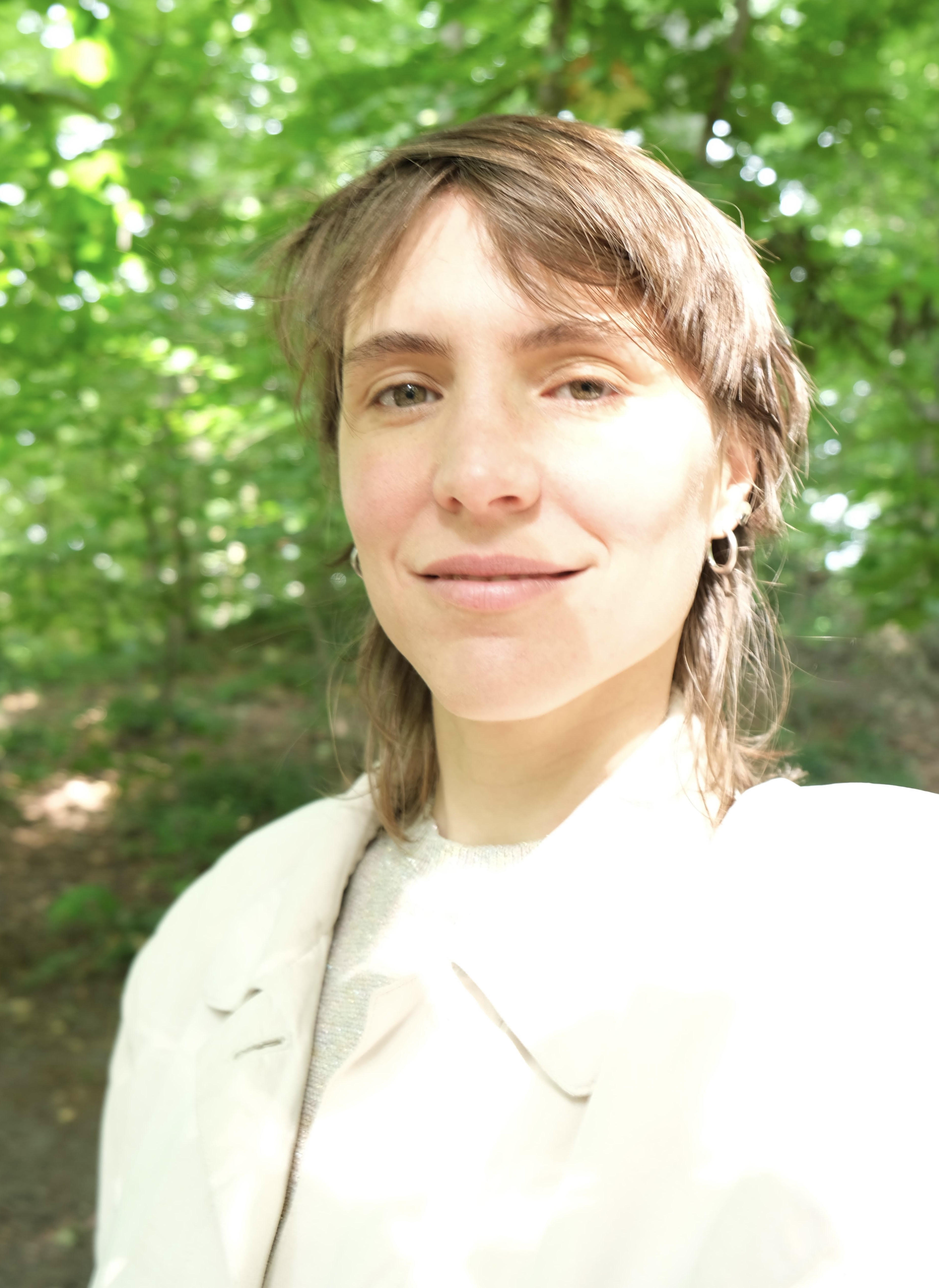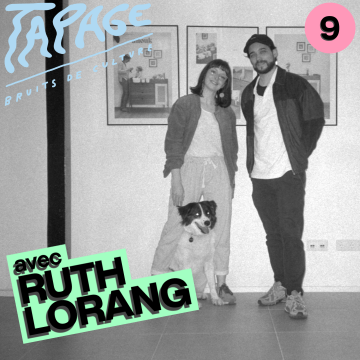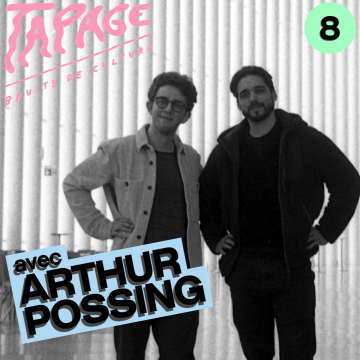27 sep. 2023Tania Soubry - Through sensuous Landscapes

Geology. Animism. Deep listening. What do these three keywords have in common, and how do they converge in Tania Soubry’s latest performance? We sat down with the transdisciplinary performer and choreographer to talk about her new project, Through sensuous Landscapes, consisting of an audio installation and two 30-minute performances that will take place at the Cercle Cité this Saturday, September 30th.

In your biography, your creation process is described as “working with listening, the relational, and the ecological, as well as at the interplay of movement, voice, sound and atmospheres”. As readers can hear in the KulturPur episode released a few years back, you truly are multidisciplinary, constantly combining different methods of art and expression and thus creating an ongoing dialogue between them. How does this approach manifest itself in your current project?
When describing my artistry, I like to use the word transdisciplinary because it's also moving between disciplines, giving it a more expansive characteristic.
I started seeing dance as a philosophy from a very early stage. To me, it's a way of thinking and of putting things in relation. That is why I expanded into other mediums, one of them being sound. Working in dance and with sound artists has made me aware of how big an impact it has and how it adds another level to the performance. It allows the choreographer to move people in an additional way. I have always been curious about how music and sound affect the listener, which has led me to Deep Listening, a term coined by Pauline Oliveros to expand our field of sensory perception. It's not just human created, it's a way of listening to dynamics, to other species, or to a space. Since I started paying more attention to listening, I experience myself and the world differently, and I realized how the visual dominated my life, even though the aural can give you a much wider perspective. It is 360 degrees, and we are immersed in it.
Another reason why sound intrigues me is because of its interconnection and interdependence with dance and movement, the same way we experience our senses with our bodies as we exist in the world. Bringing me to the anchor of the project: the political ecology, connecting with new materialism or even animism. What is our relationship to our land, how do we live, move and dance as a part of this ecosystem? My desire was also to move out of the studio, so I started by going to the Minette and gathering field recordings of nature, wind, stones, animals, etc.

I saw in the project description that you worked with Jose Macabra, who is a sound artist. How would you describe your collaborative process?
Jose was my coach for the field recordings, as this was the first time that I used this method. After I described my concept to him, he guided me, gave me feedback and suggestions, and he assisted me in putting my ideas into shape. He is an Ableton specialist, works a lot with field recordings, and has so much experience as a sound artist. He also helps me in creating the setup for the performance: which mics to use, creating and choosing the plugins for the kind of atmosphere that we want to create.
Are the field recordings incorporated into the installation, the performance, or both?
They are in the sound installation, then they lead us into the performance, and then they come back after the performance ends. But during the performance, we actually zoom into the space that we are in at that moment, the Cercle Cité.
What does it mean to you to have this performance at Cercle Cité? Is it specifically for this location?
I do like the fact that it has open doors and anybody passing by might catch a glimpse, that's something I find really appealing about it. Of course, it also has a lot of history, having been the headquarters of the European Coal and Steel Community – which was sort of the foundation of the European Union. Which connects us back to the Minette, its land and our exploitation of its mineral resources that took billions of years to form and that gave this country its wealth. So, I asked myself again, what is the acknowledgement for that? What is our relationship to that land? I was curious and hoping to find any sort of animistic stories about that land, like folk stories or songs about the land as a relational place. So, I went there to listen and record all these species and the conversations that are happening – that was my way of approaching the intention of finding animistic stories.
I did make the performance specifically for this location. On the one hand we amplify the building, we work with that space and the resonance in that space. On the other hand, there is the connection between the building and the Minette, the origin of the recordings for the sound installation.
From past projects, we know that the voice is a very important component of your art. Can this also be said for Through sensuous landscapes?
Yes, the voice will come into play again for this project, more specifically the performer’s voices. This time, I focused on the not-musical side of the voice. We are not thinking about scales or notes, we are really just thinking about sensations. So, we approached the voice as vibrations in the body first and foremost. Sending the voice into body parts and – at the same time – the voice sounding from these body parts. I call it “sounding the body landscape”. The sensing of the vibrations is the impulse for us to constantly shift and move, so the voice becomes the stimulation to move at all times.
We are moving air, and these vibrations move us. This, to me is the metaphor of shifting, like the tectonic plates or the sediments, which are gradually shifting over a long period of time. Our voices are also recorded and amplified, and then gradually they are overlayered to create sediments as well.
You perform this piece with two other dancers. What can you tell us about Laura Doehler and Christine Sollie?
I have known Laura for 20 years now, and we studied in the same school. I am in her collective in the UK, so we have a habit of going into the studio together every week, practicing together. None of the people I worked with on my previous piece are from Luxembourg or close by, and I wanted to have at least one performer from that piece to be part of this because I see it as a continuation. I just knew that she was really well suited for this material.
I met Christina quite recently through my sound assistant in Brussels, and then we met again in the UK in March. We share the same interests of deep listening and sound, and she had the same mentor that I have, Salome Voegelin. We just have very similar interests and practices, which is actually quite rare.
Given that the voice plays an important role in this piece, was it a conscious choice to use female dancers, given that the female voice is quite different from the male voice?
I think it happened in part because of the people who are closest to me, who I have these exchanges with, and who this project is suited for. But I am also aware that capitalism and the forces that are extracting the resources from the earth are the same who have been exploiting female bodies. So, for me, there is a relationship between how both the land and women's bodies have been used. It is quite a feminist approach.
For the performance, you described that the sound installation chimes in and out at the beginning respectively at the end of the performance. Can one exist without the other?
Yes, they could absolutely exist separately. The performance could exist entirely without a sound installation. In the end, they are two projects under the umbrella of the same research. Even though there's that whole question of the specificity of it, I think it could also travel. There is something about bringing specificity to another place. I see it as part of a journey; it has room to grow. I feel like it is rather a work in progress than a finished one.
You mentioned earlier that the voice, the sound is not necessarily musical. Is it improvised? Is there a music score?
There is a score for the performance that I have shared with the two other dancers, but nothing is set in stone, neither the movement nor the sound that we create.
In this case, it is important to work with people who are familiar with the practice because you need to have that sensitivity and awareness, that deep listening to your body, to the sound and to the space, while completely responding to the moment and the audience. It really is going to be different each time.
So what can we imagine that score to look like? Are there notes? Are there little drawings?
Yes, so there is one drawing I made and there are bullet points explaining the dramaturgy.
We are listening to the space and to our humming. We are letting ourselves be moved. It's like an instruction manual with questions. We will be guided by the score, but each of us has our own way of interpreting the score. The diversity of that is another interesting part of it.
My last question is about the title. In which language did you write the title first?
Actually, it was in Luxembourgish, but I was influenced by a book that I was reading in English called The Spell of the Sensuous by David Abram. The book also mentions how our language is born from its central relationship with the landscape and how you can find hints towards that in semantics. Where do words come from? Can I hear a landscape in words? What is the relation of a language to a place and what imagery does it use? But that's another journey that I haven't fully finished yet.
Tania Soubry is a trans-disciplinary performer and choreographer working with listening, the relational and the ecological, as well as at the interplay of movement, voice, sound and atmospheres. Through sensuousness, humour and solidarity, her practice and work are motivated by a poetic re-enchantment of the world. She co-founded Vibrant Matter, a non-profit organization with a focus on choreography and performance; a dance between matter and the senses. She studied contemporary dance and dance theatre at SEAD (AT) and LABAN (U.K.), and completed with an MA in Contemporary Dance Performance at The Place and an MA in Performance Making at Goldsmiths (U.K.). In 2002 she received a dance web scholarship during the ImPulsTanz Festival in Vienna and in 2004 she did a work placement with the Trisha Brown Dance company in New York. As a choreographer and artist she created and toured work in Europe, Canada and Hong Kong, from stage performances, to immersive work, to a gallery installation. As a dancer and collaborator she worked with collectives, artists, choreographers and companies, such as Exit Map (U.K.), Tino Segal, Pepa Ubera (U.K) and Vedanza (LU).
Les plus populaires
- 26 juin. 2024
- 28 juin. 2024
- 05 juil. 2024
- 04 juil. 2024
ARTICLES
Videos
26 juil. 2024TAPAGE avec Ruth Lorang
Articles
22 juil. 2024Le fabuleux destin de Raphael Tanios
Videos
19 juil. 2024

